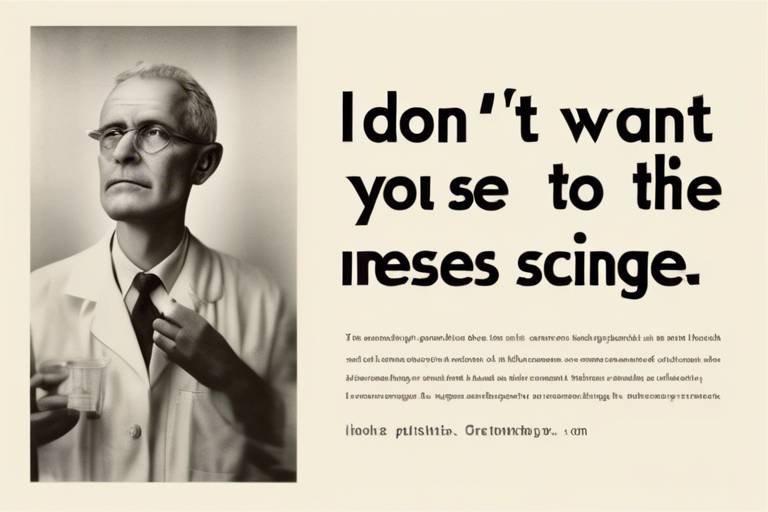Causality - The Philosophical Foundation of Scientific Laws
Causality is a concept that permeates our understanding of the universe, acting as the backbone of both philosophical inquiry and scientific exploration. At its core, causality refers to the relationship between causes and effects—essentially, it’s the reason why things happen the way they do. Imagine a chain reaction: one event triggers another, leading to a series of outcomes. This chain of events is not just a mere coincidence; it is rooted in a fundamental principle that shapes our reality. Without causality, our understanding of the natural world would be reduced to a series of random occurrences, devoid of meaning or predictability.
In philosophy, causality serves as a critical framework for examining the nature of existence. Think about it—how can we make sense of our experiences if we don't understand why things happen? The concept of causality allows us to draw connections between events, leading to deeper insights into the laws that govern our universe. It raises essential questions: What causes something to happen? Can we truly know the cause of an event? These inquiries not only fuel philosophical debates but also inspire scientific research aimed at uncovering the mechanisms behind natural phenomena.
As we delve deeper into the significance of causality, it becomes apparent that it is not merely an abstract idea but a practical tool that scientists utilize to explore and explain the world around us. From the earliest days of scientific inquiry, understanding causation has been pivotal in formulating hypotheses and conducting experiments. The implications of causality extend beyond the realm of science; they infiltrate ethics, law, and social sciences, influencing how we make decisions and shape policies. Thus, grasping the essence of causality is not just an academic exercise; it is a vital aspect of navigating the complexities of life.
In the sections that follow, we will explore the nature of causality, its historical perspectives, its role in scientific inquiry, and the far-reaching implications it holds for various fields. By examining these elements, we will uncover the intricate tapestry of causality and its profound impact on our understanding of the world.
- What is causality? Causality refers to the relationship between causes and effects, explaining why events occur in a particular way.
- Why is causality important in science? It helps scientists establish relationships between variables, allowing for the formulation of hypotheses and the conduct of experiments.
- How has causality been viewed historically? Philosophers like Aristotle and Hume have contributed significantly to our understanding of causality, shaping modern thought.
- What are the implications of understanding causality? Understanding causality influences decision-making in ethics, law, and social sciences, affecting policies and societal norms.

The Nature of Causality
Causality is a fundamental concept that lies at the heart of both philosophy and science. It refers to the relationship between causes and effects, essentially asking the question: What makes things happen? This inquiry is not just a theoretical exercise; it is crucial for understanding the world around us. Imagine a world where events occur randomly, without any connection to one another. It would be chaotic and unpredictable, wouldn't it? Fortunately, causality provides a framework that helps us make sense of our experiences and observations.
The complexity of causality arises from its various interpretations and implications. In philosophy, causality is often discussed in terms of necessity and sufficiency. To illustrate, consider the classic example of a light switch: flipping the switch is the cause, while the light turning on is the effect. However, this relationship can become murky when we introduce other variables, such as a broken bulb. Here, the switch's action does not guarantee the light will illuminate, leading us to question how we define causation. This interplay between cause and effect is what makes causality so rich and intricate.
Moreover, causality is not just a philosophical notion; it is a cornerstone of scientific inquiry. Scientists rely on causal relationships to formulate hypotheses and conduct experiments. For example, if researchers want to determine whether a new drug effectively treats a disease, they must establish a clear causal link between the drug's administration and the patient's recovery. This process often involves rigorous testing and validation, highlighting the importance of causality in producing reliable knowledge.
In everyday life, we constantly navigate a web of causal relationships. From the simple act of watering a plant and watching it grow to the complex dynamics of social interactions, understanding causality helps us predict outcomes and make informed decisions. For instance, if we know that exercising regularly leads to better health, we are more likely to adopt a fitness routine. This practical application of causality underscores its relevance beyond academic discourse.
Ultimately, grappling with the nature of causality invites us to explore deeper questions about reality. Are our perceptions of cause and effect merely illusions shaped by our experiences? Or do they reflect an underlying order in the universe? These questions not only challenge our understanding but also inspire further inquiry into the very fabric of existence.

Historical Perspectives on Causality
Causality has long been a cornerstone of philosophical inquiry, shaping our understanding of the world and the laws that govern it. The journey through the historical perspectives on causality is akin to exploring a rich tapestry woven with the thoughts of great minds. From the ancient musings of Aristotle to the skeptical inquiries of David Hume, each philosopher has contributed to the intricate understanding of how causes relate to effects. This exploration not only highlights the evolution of thought around causality but also emphasizes its significance in modern scientific discourse.
Aristotle, often regarded as the father of Western philosophy, laid the groundwork for our contemporary understanding of causality. He introduced the concept of the four causes, which provided a comprehensive framework for analyzing why things happen. These causes include:
- Material Cause: The substance out of which something is made.
- Formal Cause: The form or essence of a thing.
- Efficient Cause: The agent or force that brings something into being.
- Final Cause: The purpose or end for which a thing exists.
By categorizing causes in this way, Aristotle allowed for a multifaceted approach to understanding the natural world, encouraging future thinkers to consider not just the immediate causes of events but their broader implications as well.
Fast forward to the 18th century, and we encounter the profound skepticism of David Hume. Hume challenged the prevailing notions of causality, asserting that our understanding of cause and effect is not derived from logical necessity but rather from habit and experience. He famously argued that we cannot observe causation directly; instead, we only see one event following another. This led him to conclude that causality is a mental construct rather than an inherent property of the world. Hume's insights sparked debates that resonate even today, pushing philosophers to reconsider the foundations of causal reasoning.
The implications of Hume's skepticism were far-reaching, influencing not only philosophy but also the burgeoning field of science. The tension between Aristotle’s foundational principles and Hume’s radical skepticism laid the groundwork for modern scientific methods. Scientists began to recognize the importance of empirical evidence and experimentation in establishing causal relationships, moving away from purely philosophical speculation.
In summary, the historical perspectives on causality illustrate a dynamic interplay between different philosophical doctrines. Aristotle’s systematic approach provided a solid foundation, while Hume’s skepticism challenged thinkers to refine their understanding of causal relationships. This ongoing dialogue continues to shape our comprehension of causality, ensuring its relevance in both philosophy and science today.
- What is causality? Causality refers to the relationship between causes and effects, explaining how one event leads to another.
- Who were the key philosophers in the study of causality? Notable philosophers include Aristotle, who introduced the four causes, and David Hume, who questioned the nature of causation.
- How does causality impact scientific inquiry? Causality is crucial in scientific methods, guiding researchers in establishing causal relationships through experimentation and observation.
- What are Aristotle's four causes? They are material, formal, efficient, and final causes, each providing a different perspective on why things happen.
- What was Hume's main argument about causality? Hume argued that our understanding of causality is based on habit and experience rather than logical necessity.

Aristotle's Four Causes
Aristotle, one of the most influential philosophers in history, introduced a framework for understanding causality that remains relevant today. He identified four distinct types of causes that explain why things exist or happen. These are the material cause, formal cause, efficient cause, and final cause. Each cause provides a different perspective on the nature of causality, allowing us to grasp the complexity of the world around us.
The material cause refers to the substance or matter from which something is made. For instance, if we consider a wooden table, the material cause would be the wood itself. It answers the question, "What is it made of?" This concept is fundamental in both philosophy and science, as understanding the materials involved can lead to deeper insights into the properties and behaviors of objects.
Next, we have the formal cause, which pertains to the form or arrangement of the matter. In our wooden table example, the formal cause would be the design or blueprint that dictates how the wood is shaped and assembled. It answers the question, "What is its form?" This cause emphasizes that the essence of an object is not merely in its material composition but also in how that material is organized and structured.
The efficient cause is perhaps the most straightforward of Aristotle's causes, as it relates to the agent or force that brings something into being. In the case of our table, the efficient cause would be the carpenter who crafted it. This cause answers the question, "Who or what made it?" Understanding the efficient cause is crucial in various fields, especially in scientific inquiry, where identifying the agent of change is essential for establishing causality.
Lastly, we encounter the final cause, which refers to the purpose or end for which something exists. Why does the wooden table exist? Its final cause is to provide a surface for dining, working, or playing games. This cause answers the question, "What is its purpose?" Aristotle argued that understanding the final cause is vital for comprehending the full nature of an object, as it reveals the intentions behind its creation.
In summary, Aristotle's four causes provide a comprehensive framework for understanding causality. By examining the material, formal, efficient, and final causes, we can gain a holistic view of why things exist and how they function. This approach not only enriches philosophical discourse but also enhances scientific methodologies, allowing us to explore the intricate web of relationships that define our universe.
- What are Aristotle's four causes? Aristotle's four causes are material, formal, efficient, and final causes, each providing a different perspective on causality.
- Why are Aristotle's causes important? They help us understand the complexity of existence and the relationships between objects and their purposes.
- How do these causes relate to modern science? They offer a foundational framework for scientific inquiry, helping to clarify how and why phenomena occur.

Hume's Skepticism
David Hume, an 18th-century Scottish philosopher, is often regarded as one of the most significant figures in the realm of skepticism, particularly when it comes to the concept of causality. Hume's take on causation is both fascinating and challenging, as he proposed that our understanding of cause and effect is not rooted in logical necessity but rather in our habits and experiences. Imagine you're at a carnival, watching a magician pull a rabbit out of a hat. You might think there's a direct cause—the magician's actions—leading to the effect of the rabbit appearing. However, Hume would argue that this perceived connection is merely a product of your expectations formed through repeated experiences rather than an inherent truth.
Hume famously stated that we can never observe causation directly; we only witness one event following another. For instance, when you drop a ball, you see it fall to the ground, but you cannot see the 'force' that causes it to fall. This leads to his conclusion that our belief in causality is based on custom and habit rather than any rational justification. In essence, we come to expect certain outcomes because we have seen them happen repeatedly, not because we can prove that one event necessarily causes another.
To further illustrate Hume's skepticism, consider the following points:
- Inductive Reasoning: Hume pointed out that much of our understanding of the world relies on inductive reasoning, where we generalize from specific instances. However, he argued that this method is fundamentally flawed, as past occurrences do not guarantee future outcomes.
- Problem of Induction: This refers to the challenge of justifying inductive reasoning. Hume questioned how we can assume that the future will resemble the past, a foundational assumption in science and daily life.
- Empirical Evidence: Hume emphasized that our knowledge is limited to what we can observe. Since causation cannot be directly observed, he believed that we should remain skeptical about our assumptions regarding causal relationships.
Hume's skepticism has had profound implications for modern philosophy and scientific inquiry. It challenges us to think critically about how we interpret the world around us and to question the validity of our assumptions. His work invites us to consider the nature of our beliefs and the foundations upon which they are built. In a world where data and evidence reign supreme, Hume's perspective serves as a reminder that our understanding of causality is not as straightforward as it may seem.
In summary, while Hume's skepticism may initially seem disheartening, it actually encourages a deeper exploration of our beliefs and the mechanisms behind them. By recognizing the limitations of our understanding, we open ourselves up to a more nuanced view of causality, one that acknowledges the complexities of human experience and the intricacies of the natural world.
1. What is Hume's main argument regarding causality?
Hume argues that our understanding of causality is based on habit and experience rather than logical necessity. We cannot directly observe causation, leading to skepticism about our assumptions.
2. How does Hume's skepticism affect scientific inquiry?
Hume's skepticism encourages scientists to critically evaluate their assumptions about causation, emphasizing the need for empirical evidence and caution in generalizing from observations.
3. What is the problem of induction?
The problem of induction refers to the challenge of justifying the assumption that the future will resemble the past, which is a fundamental aspect of inductive reasoning.
4. Why is Hume's perspective still relevant today?
Hume's perspective remains relevant as it challenges us to critically assess our beliefs and the foundations of our knowledge, especially in a world increasingly driven by data and empirical evidence.

Causality in Scientific Inquiry
Causality is not just a philosophical concept; it is the bedrock of scientific inquiry. When scientists embark on their quests to understand the universe, they are essentially trying to unravel the intricate web of cause and effect that governs everything from the smallest particles to the vast cosmos. But how do they go about establishing these causal relationships? It’s a fascinating journey that involves meticulous observation, experimentation, and a dash of creativity.
At the heart of scientific inquiry lies the **scientific method**, a systematic approach that allows researchers to test hypotheses and draw conclusions based on empirical evidence. This method is deeply intertwined with the concept of causality. Scientists formulate hypotheses that propose a causal relationship between variables, then design experiments to test these hypotheses. For instance, consider a simple experiment to determine whether sunlight affects plant growth. A scientist might hypothesize that "increased sunlight exposure leads to higher growth rates in plants." To test this, they would set up controlled conditions where one group of plants receives ample sunlight while another group is kept in the shade. By comparing the growth of both groups, the scientist can draw conclusions about the causal relationship between sunlight and plant growth.
The **importance of experimentation** cannot be overstated. It is through carefully designed experiments that scientists can isolate variables and determine which factors are truly responsible for observed effects. This process often involves controlling for confounding variables—those pesky factors that can skew results if not accounted for. For example, in our plant growth experiment, factors like soil quality, water availability, and temperature must be kept constant to ensure that any differences in growth can be attributed solely to sunlight.
Moreover, the role of **observational studies** in establishing causality cannot be overlooked. While experiments provide a powerful means of testing causal relationships, not all scientific inquiries can be conducted in a controlled environment. In such cases, scientists rely on observational data to infer causality. For instance, epidemiologists often study the relationship between lifestyle factors and health outcomes by analyzing data from large populations. They might observe that individuals who smoke tend to have higher rates of lung cancer. However, establishing causality in such cases is more challenging, as many confounding factors—such as genetics and environmental influences—can come into play.
To aid in this endeavor, scientists employ **statistical approaches** to analyze data and infer causal relationships. Techniques like regression analysis allow researchers to quantify the strength and direction of relationships between variables, helping to illuminate potential causal pathways. However, it is crucial to remember that correlation does not imply causation. Just because two variables are related does not mean one causes the other. This is where rigorous statistical methods and critical thinking come into play, guiding scientists to draw valid conclusions from their data.
In summary, causality is a vital component of scientific inquiry, shaping how researchers formulate hypotheses, design experiments, and analyze data. By establishing causal relationships, scientists can deepen our understanding of the natural world and make informed predictions about future phenomena. As we continue to unravel the complexities of causality, we open up new avenues for discovery and innovation across various fields of study.
- What is causality? Causality refers to the relationship between causes and effects, explaining how one event leads to another.
- Why is causality important in science? Causality helps scientists understand the mechanisms behind natural phenomena and enables them to make predictions based on established relationships.
- How do scientists establish causality? Scientists establish causality through controlled experiments, observational studies, and statistical analysis to interpret data accurately.
- What is the difference between correlation and causation? Correlation indicates a relationship between two variables, while causation confirms that one variable directly influences the other.

Experimental Design and Causality
When it comes to establishing causality, the design of an experiment is absolutely critical. Think of it as laying the groundwork for a scientific investigation. Just like a well-constructed building needs a solid foundation, a good experiment requires careful planning to ensure that the results are valid and reliable. But what makes an experimental design effective in determining cause and effect? Well, there are several key principles that researchers must consider.
First and foremost, one of the most important aspects of experimental design is the concept of control. In a well-designed experiment, researchers must control for extraneous variables—those pesky factors that can muddy the waters and lead to misleading conclusions. By keeping these variables constant, scientists can isolate the effect of the independent variable on the dependent variable, thereby demonstrating a clearer causal relationship. For instance, if a researcher is studying the effect of a new drug on blood pressure, they need to ensure that other factors, such as diet and exercise, are kept constant among participants.
Another critical element is randomization. This means that participants should be assigned to different groups in a random manner to eliminate bias. Imagine flipping a coin to decide who gets the treatment and who gets the placebo; this random assignment helps ensure that the groups are comparable at the start of the experiment. By doing this, researchers can be more confident that any differences observed in outcomes are due to the treatment itself rather than pre-existing differences between groups.
Moreover, the sample size plays a significant role in the robustness of an experiment. A larger sample size generally leads to more reliable results because it reduces the impact of random variation. Consider it like casting a wider net while fishing; the more fish you catch, the better your chances of understanding the overall population. In scientific terms, a larger sample size increases the statistical power of an experiment, allowing researchers to detect a true effect if it exists.
Lastly, researchers must also pay attention to the replicability of their experiments. This means that other scientists should be able to repeat the experiment and achieve similar results. Replicability is the cornerstone of scientific credibility; it allows findings to be verified and built upon. If an experiment cannot be replicated, it raises questions about its validity and the conclusions drawn from it.
In summary, effective experimental design is pivotal in establishing causality. By controlling extraneous variables, utilizing randomization, ensuring an adequate sample size, and emphasizing replicability, researchers can confidently draw conclusions about cause-and-effect relationships. The implications of these principles extend beyond the laboratory; they shape our understanding of everything from medical treatments to social interventions. As we continue to explore the intricate dance of cause and effect, the importance of rigorous experimental design cannot be overstated.
- What is the difference between correlation and causation? Correlation refers to a relationship between two variables, but it does not imply that one causes the other. Causation indicates a direct cause-and-effect relationship.
- Why is randomization important in experiments? Randomization helps eliminate bias and ensures that the groups being compared are similar in all respects except for the treatment being tested.
- How does sample size affect the results of an experiment? A larger sample size increases the reliability of results and reduces the impact of random variation, making it easier to detect true effects.
- What does replicability mean in scientific research? Replicability means that an experiment can be repeated by other researchers and yield similar results, which is crucial for validating findings.

Statistical Approaches to Causation
When we dive into the realm of causation, we quickly realize that the complexities of the natural world demand a more rigorous framework for understanding these relationships. This is where statistical approaches come into play. By employing various statistical methods, researchers can sift through mountains of data to uncover potential causal links that might not be immediately apparent. One of the key tools in this arsenal is regression analysis, which allows scientists to model the relationship between a dependent variable and one or more independent variables.
Imagine you're trying to figure out what influences the growth of plants. You might collect data on several factors such as sunlight, water, soil quality, and temperature. Using regression analysis, you can quantify how much each of these factors contributes to plant growth. This method doesn't just tell you if a relationship exists; it helps you understand the strength and direction of that relationship. For instance, you might find that sunlight has a strong positive effect on growth, while excessive water may actually hinder it.
However, it’s crucial to remember that correlation does not imply causation. Just because two variables move together does not mean one causes the other. This is where the concept of confounding variables comes into play. These are extraneous variables that can influence both the independent and dependent variables, leading to misleading conclusions. For example, if you observe that ice cream sales and drowning incidents both rise in the summer, it would be a gross oversimplification to conclude that ice cream consumption causes drowning. The underlying factor here is the warm weather, which affects both variables.
To mitigate such issues, researchers often employ techniques like propensity score matching, which helps create comparable groups in observational studies. This method attempts to mimic randomization by matching subjects in treatment and control groups based on their characteristics, thereby reducing bias in the estimation of causal effects. In a nutshell, these statistical tools are not just about crunching numbers; they are about making informed decisions based on the best available evidence.
Furthermore, the rise of machine learning has introduced new dimensions to causal inference. Algorithms can analyze vast datasets to identify patterns and potential causal relationships that traditional methods might miss. For example, a machine learning model could analyze numerous health indicators to determine the likelihood of developing a particular disease, taking into account myriad factors in ways that human analysts might overlook.
In summary, statistical approaches to causation are vital for drawing meaningful conclusions from data. They allow researchers to explore complex relationships and make informed decisions in various fields, from healthcare to economics. However, it's essential to apply these methods judiciously, always keeping in mind the fundamental principle that correlation does not equal causation. By doing so, we can better navigate the intricate web of cause and effect that shapes our understanding of the world.
- What is the difference between correlation and causation?
Correlation indicates a relationship between two variables, while causation implies that one variable directly affects the other. - How can statistical methods help in establishing causation?
Statistical methods, such as regression analysis and propensity score matching, can help isolate variables and clarify their relationships. - Can machine learning be used to determine causation?
Yes, machine learning can help identify patterns in large datasets, potentially revealing causal relationships that traditional methods may not uncover.

The Implications of Causality
Causality isn't just a dry philosophical concept; it's the backbone of how we navigate our world. Understanding the relationship between causes and effects can significantly influence various fields, from ethics to law and even social sciences. Imagine trying to drive a car without understanding how the steering wheel affects the direction of the vehicle—it's pretty chaotic, right? Similarly, in our daily lives and decision-making processes, recognizing the causal links can lead to better outcomes.
In the realm of ethics, causality helps shape our moral responsibilities. For instance, if a person causes harm to another, understanding the causal chain of events is crucial for determining culpability. This is where the principle of causal responsibility comes into play. If someone accidentally spills coffee on a computer, leading to data loss, the question arises: should they be held accountable? The answer often hinges on whether the action was a direct cause of the damage or if other factors were at play.
In legal systems, causality is equally vital. Courts often rely on establishing a clear causal link between actions and consequences to determine guilt or liability. This is particularly evident in personal injury cases, where plaintiffs must prove that the defendant's actions directly caused their injuries. The legal concept of proximate cause is a prime example, which focuses on whether the harm was a foreseeable result of the defendant's actions. Without a solid grasp of causality, the judicial process would be like a ship sailing without a compass—directionless and chaotic.
Moreover, in the social sciences, causality plays a pivotal role in understanding human behavior and societal trends. Researchers often seek to uncover causal relationships to inform policies that can effectively address social issues. For instance, if a study finds that increased access to education leads to lower crime rates, policymakers can use this information to advocate for educational reforms. This causal insight is invaluable, as it helps in crafting strategies that can lead to tangible improvements in society.
However, it's important to note that establishing causality is not always straightforward. In many cases, multiple factors can intertwine, creating a complex web of influences. For example, consider the relationship between poverty and crime. While poverty may lead to higher crime rates, other factors like community support, education, and law enforcement also play significant roles. Therefore, a nuanced understanding of causality is essential for effective intervention.
To summarize, the implications of causality stretch far beyond academic discussions. They permeate our ethical considerations, legal frameworks, and social policies. By recognizing and analyzing causal relationships, we equip ourselves with the tools to make informed decisions, create effective laws, and foster societal improvements. In a world where actions have consequences, understanding causality is not just beneficial; it's essential.
- What is causality? Causality refers to the relationship between causes and effects, explaining how one event can lead to another.
- Why is causality important in ethics? It helps determine moral responsibility and accountability for actions that lead to harm.
- How does causality affect legal systems? Establishing a clear causal link is crucial for determining guilt or liability in court cases.
- Can causality be complex? Yes, multiple factors can influence outcomes, making it essential to analyze causal relationships carefully.
Frequently Asked Questions
- What is causality?
Causality is the relationship between causes and effects. It helps us understand how one event can lead to another, forming the backbone of both philosophical discussions and scientific investigations.
- Why is causality important in philosophy?
Causality is crucial in philosophy because it influences our understanding of reality, knowledge, and existence. Philosophers like Aristotle and Hume have explored its complexities, shaping our modern interpretations and applications.
- How did Aristotle contribute to our understanding of causality?
Aristotle introduced the concept of four types of causes: material, formal, efficient, and final. Each type provides a different lens through which to view the reasons behind phenomena, enriching our grasp of the natural world.
- What was Hume's perspective on causality?
David Hume challenged traditional views on causality, suggesting that our understanding is more about habit and less about logical necessity. His skepticism has had a lasting impact on philosophical thought and scientific inquiry.
- How is causality established in scientific research?
In scientific research, causality is established through careful experimentation and observation. Scientists design experiments to isolate variables and determine how changes in one factor can lead to changes in another.
- What role does experimental design play in establishing causality?
Effective experimental design is essential for isolating causal variables. It ensures that researchers can draw valid conclusions about the relationships between different factors, minimizing the influence of confounding variables.
- How do statistical methods help in understanding causality?
Statistical methods, like regression analysis, allow researchers to infer causal relationships from observational data. These techniques help in identifying patterns and correlations that can suggest causative links between variables.
- What are the implications of understanding causality?
Understanding causality has significant implications across various fields, including ethics, law, and social sciences. It informs decision-making and policy formulation by helping us understand the potential consequences of actions.



















